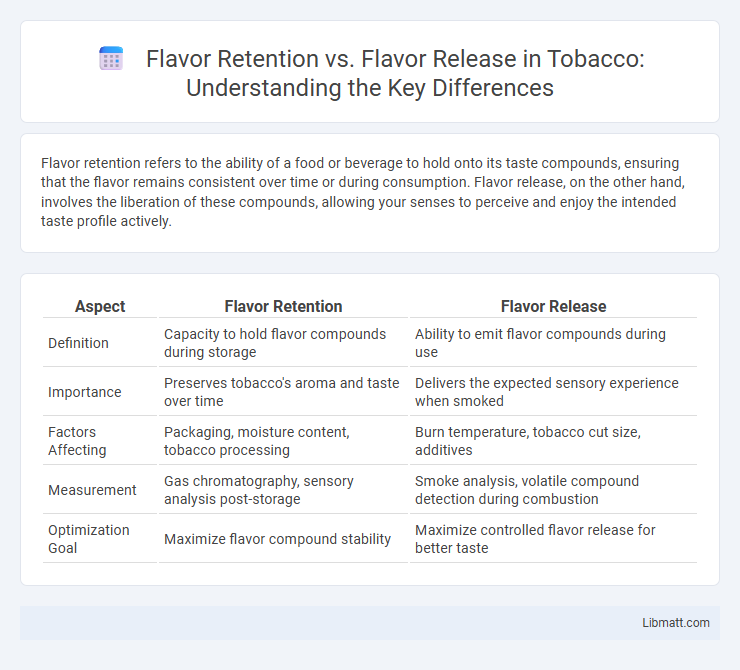Flavor retention refers to the ability of a food or beverage to hold onto its taste compounds, ensuring that the flavor remains consistent over time or during consumption. Flavor release, on the other hand, involves the liberation of these compounds, allowing your senses to perceive and enjoy the intended taste profile actively.
Table of Comparison
| Aspect | Flavor Retention | Flavor Release |
|---|---|---|
| Definition | Capacity to hold flavor compounds during storage | Ability to emit flavor compounds during use |
| Importance | Preserves tobacco's aroma and taste over time | Delivers the expected sensory experience when smoked |
| Factors Affecting | Packaging, moisture content, tobacco processing | Burn temperature, tobacco cut size, additives |
| Measurement | Gas chromatography, sensory analysis post-storage | Smoke analysis, volatile compound detection during combustion |
| Optimization Goal | Maximize flavor compound stability | Maximize controlled flavor release for better taste |
Understanding Flavor Retention and Flavor Release
Flavor retention refers to the ability of a food or beverage to maintain its taste characteristics over time, preserving the intensity and complexity of its original flavor profile. Flavor release describes the process by which volatile compounds are emitted during consumption, activating sensory receptors and creating the perception of taste and aroma. Understanding the balance between flavor retention and flavor release is essential for optimizing product quality and ensuring your sensory experience remains rich and enjoyable.
The Science Behind Flavor Molecules
Flavor retention involves the ability of certain matrices or carriers to hold flavor molecules without immediate release, often influenced by molecular interactions such as hydrogen bonding and hydrophobic effects. Flavor release depends on the volatility and solubility of flavor compounds, with key molecules like esters, aldehydes, and terpenes vaporizing or interacting with taste receptors during consumption. Understanding the chemical structure and intermolecular forces of flavor molecules enables precise control over flavor delivery in food and beverage products.
Key Factors Affecting Flavor Retention
Flavor retention is significantly influenced by factors such as ingredient composition, processing methods, and storage conditions. High lipid content and encapsulation techniques enhance flavor retention by protecting volatile compounds from oxidation and evaporation. Temperature, humidity, and packaging permeability also play crucial roles in preserving flavor integrity over time.
Mechanisms of Flavor Release in Food
Flavor release in food primarily occurs through mechanisms such as volatilization, diffusion, and enzymatic reactions that transform flavor precursors into aromatic compounds. The matrix of the food, including fat content, moisture, and texture, plays a crucial role in controlling the retention and timely release of these volatile molecules. Your experience of flavor depends on how these mechanisms balance the retention of flavor compounds during storage and their release during consumption.
Ingredients that Enhance Flavor Retention
Ingredients like maltodextrin and cyclodextrins play a crucial role in enhancing flavor retention by encapsulating volatile compounds, preventing their premature evaporation. Emulsifiers such as lecithin stabilize flavor molecules within food matrices, ensuring prolonged sensory impact during consumption. Your recipes benefit significantly from incorporating natural antioxidants like rosemary extract, which protects flavor integrity by reducing oxidation.
Techniques to Maximize Flavor Release
Techniques to maximize flavor release focus on enhancing volatile compound evaporation to improve sensory perception. Methods such as adjusting temperature, using encapsulation technologies, and optimizing ingredient interactions help intensify aroma and taste during consumption. You can boost flavor impact by carefully controlling these factors to ensure the desired profile is fully experienced.
Impact of Cooking Methods on Flavor Dynamics
Cooking methods significantly influence flavor retention and release by altering the chemical composition and volatility of flavor compounds. Techniques like steaming and sous-vide preserve delicate aromas by minimizing heat exposure, while frying and grilling promote flavor release through Maillard reactions and caramelization. Understanding these dynamics helps you choose methods that maximize flavor intensity or subtlety in your dishes.
Consumer Preferences: Retained vs Released Flavors
Consumer preferences often balance between flavor retention and flavor release, depending on the food product and eating experience desired. Retained flavors provide consistent taste throughout consumption, enhancing products like beverages and snacks that benefit from prolonged flavor impact. Your choice may favor released flavors in products such as chewing gum or chewing candies where a burst of intense taste followed by gradual fading is preferred.
Innovations in Flavor Encapsulation
Innovations in flavor encapsulation have significantly improved flavor retention by protecting volatile compounds from premature degradation, ensuring freshness during storage. Advanced microencapsulation techniques enable controlled flavor release targeted at specific conditions like temperature or pH, enhancing sensory experience upon consumption. Your products can benefit from these technologies by delivering consistent and intense flavor profiles through optimized encapsulation methods.
Future Trends in Flavor Technology
Advancements in flavor technology emphasize balancing flavor retention and flavor release to enhance consumer experience in food and beverages. Innovative encapsulation techniques and controlled-release systems are designed to maintain flavor integrity during processing while ensuring optimal flavor release at consumption. Your products can benefit from these future trends by delivering consistent taste profiles and prolonged flavor satisfaction.
Flavor retention vs flavor release Infographic

 libmatt.com
libmatt.com